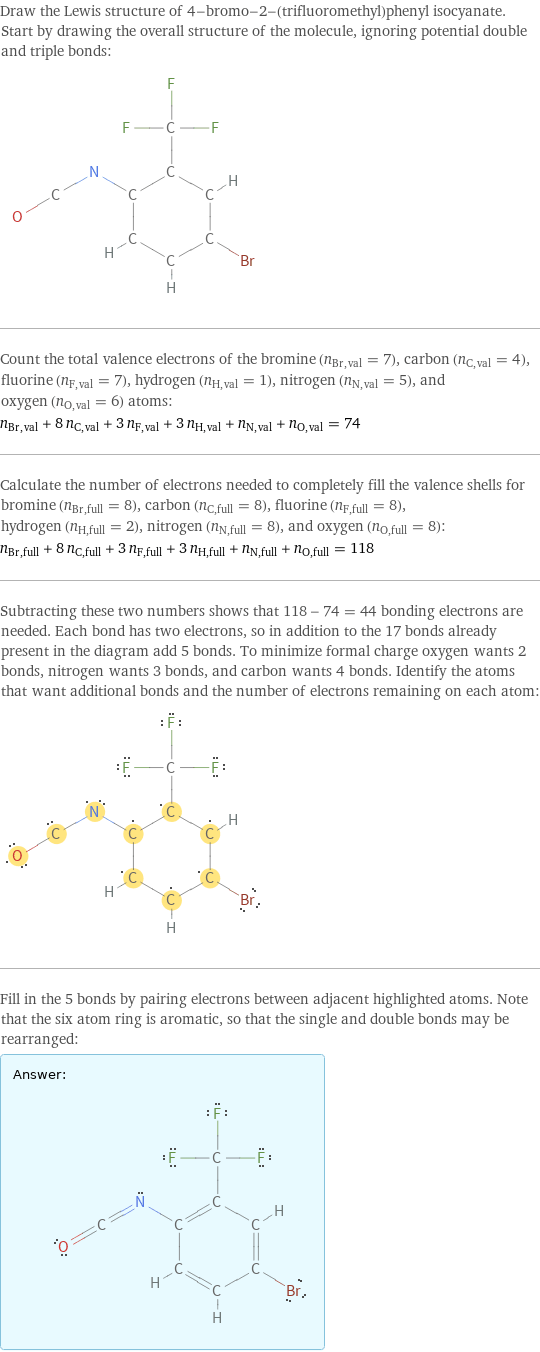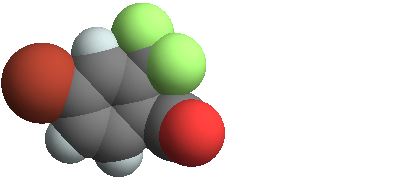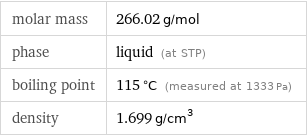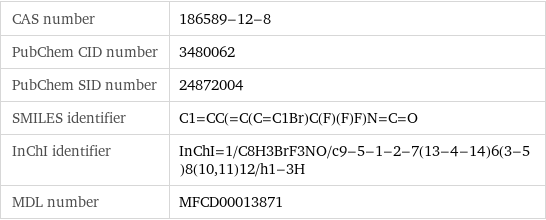Input interpretation

4-bromo-2-(trifluoromethyl)phenyl isocyanate
Chemical names and formulas

formula | BrC_6H_3(CF_3)NCO Hill formula | C_8H_3BrF_3NO name | 4-bromo-2-(trifluoromethyl)phenyl isocyanate IUPAC name | 4-bromo-1-isocyanato-2-(trifluoromethyl)benzene alternate names | 4-bromo-1-isocyanato-2-(trifluoromethyl)benzene mass fractions | Br (bromine) 30% | C (carbon) 36.1% | F (fluorine) 21.4% | H (hydrogen) 1.14% | N (nitrogen) 5.27% | O (oxygen) 6.01%
Lewis structure

Draw the Lewis structure of 4-bromo-2-(trifluoromethyl)phenyl isocyanate. Start by drawing the overall structure of the molecule, ignoring potential double and triple bonds: Count the total valence electrons of the bromine (n_Br, val = 7), carbon (n_C, val = 4), fluorine (n_F, val = 7), hydrogen (n_H, val = 1), nitrogen (n_N, val = 5), and oxygen (n_O, val = 6) atoms: n_Br, val + 8 n_C, val + 3 n_F, val + 3 n_H, val + n_N, val + n_O, val = 74 Calculate the number of electrons needed to completely fill the valence shells for bromine (n_Br, full = 8), carbon (n_C, full = 8), fluorine (n_F, full = 8), hydrogen (n_H, full = 2), nitrogen (n_N, full = 8), and oxygen (n_O, full = 8): n_Br, full + 8 n_C, full + 3 n_F, full + 3 n_H, full + n_N, full + n_O, full = 118 Subtracting these two numbers shows that 118 - 74 = 44 bonding electrons are needed. Each bond has two electrons, so in addition to the 17 bonds already present in the diagram add 5 bonds. To minimize formal charge oxygen wants 2 bonds, nitrogen wants 3 bonds, and carbon wants 4 bonds. Identify the atoms that want additional bonds and the number of electrons remaining on each atom: Fill in the 5 bonds by pairing electrons between adjacent highlighted atoms. Note that the six atom ring is aromatic, so that the single and double bonds may be rearranged: Answer: | |
3D structure

3D structure
Basic properties

molar mass | 266.02 g/mol phase | liquid (at STP) boiling point | 115 °C (measured at 1333 Pa) density | 1.699 g/cm^3
Units

Liquid properties (at STP)

density | 1.699 g/cm^3 refractive index | 1.524
Units

Chemical identifiers

CAS number | 186589-12-8 PubChem CID number | 3480062 PubChem SID number | 24872004 SMILES identifier | C1=CC(=C(C=C1Br)C(F)(F)F)N=C=O InChI identifier | InChI=1/C8H3BrF3NO/c9-5-1-2-7(13-4-14)6(3-5)8(10, 11)12/h1-3H MDL number | MFCD00013871
Safety properties

flash point | 110 °C